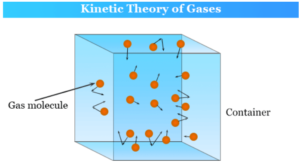Table of Contents
The kinetic theory of gases describes the three macroscopic properties of a gas in terms of the microscopic nature of the gas’s atoms and molecules. The physical properties of solids and liquids are typically described by their size, shape, mass, volume, and so on. When it comes to gases, however, there is no definite shape or size, and mass and volume are not directly measurable. The Kinetic theory of gases is useful in this situation and can be applied. The physical properties of any gas can be defined in terms of three measurable macroscopic properties using the kinetic theory of gases. The container’s pressure, volume, and temperature where the gas is stored or present.
The kinetic theory of gases is a theoretical model that describes the molecular composition of a gas using a large number of submicroscopic particles such as atoms and molecules. Furthermore, the theory explains that gas pressure is caused by particles colliding with each other and the container’s walls. Gas kinetic theory defines properties such as temperature, volume, and pressure, as well as transport properties such as viscosity and thermal conductivity, as well as mass diffusivity. It essentially explains all of the properties associated with the microscopic phenomenon.
The theory’s significance is that it aids in the development of a correlation between macroscopic properties and microscopic phenomena. In layman’s terms, the kinetic theory of gases aids in the study of molecule action. In general, gas molecules are constantly in motion and tend to collide with each other and the container walls. Furthermore, the model aids in understanding related phenomena such as Brownian motion.

Solved solutions
Question: Wherever R=8.3 J/mol-K is required, use it. At STP, calculate the volume of one mole of an ideal gas.
Solution:
![]() Pa
Pa
n=1 mol
T=273 K
R=8.3 J/mol-K
PV=nRT
![]()
![]()
![]()
Question: Wherever R=8.3 J/mol-K is required, use it.
Find the number of molecules in a volume of 1.00 at STP of an ideal gas.
Solution:
![]() Pa;
Pa; ![]() ; T=273 K; R=8.3 J/mol-K
; T=273 K; R=8.3 J/mol-K
PV=nRT
PV=![]()
N=![]()
=![]()
![]()
Question: Does the kinetic energy of the molecules increase when we place a gas cylinder on a moving van? Is the temperature rising?
Solution:
No, the molecules’ kinetic energy does not increase. This is due to the fact that when the cylinder is kept in a vehicle moving in a uniform motion, the velocity of the molecules does not increase with respect to the walls of the gas cylinder. However, if the vehicle is accelerated or decelerated, the kinetic energy of the gas changes, causing the temperature to rise.
Postulates of Kinetic Theory of Gases
- Gas molecules are made up of extremely small discrete particles. The mass and size of molecules in a gas are the same and different for different gases.
- The molecules are moving at varying speeds in all directions of space. Some are extremely fast, while others are extremely slow.
- The gas molecules collide in two ways as a result of random motion. When it collided with the container’s walls, it was referred to as a wall collision, but when it collided with itself, it was referred to as an intermolecular collision. These collisions are completely elastomeric. As a result, there is energy conservation because there is no loss of kinetic energy or momentum of the molecules as a result of this collision.
- The masses of gas molecules are assumed to be point masses. As a result, the gas sizes are very small in comparison to the distance travelled.
- The gas molecules have no intermolecular attraction, especially at low pressure. As a result, one molecule can exert pressure without regard for the influence of other molecules.
FAQs
What is the kinetic theory's main foundation?
Kinetic theory explains the behaviour of gases by assuming that gas is made up of rapidly moving atoms or molecules.
Q. What are the three main points of gas kinetic theory?
Ans: Kinetic theory is based on three major assumptions:
(i) When molecules collide, no energy is gained or lost.
(ii)The molecules in a gas take up very little space in relation to the container they are in.
(iii)The molecules are constantly moving in a straight line.



